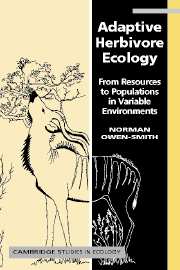Book contents
- Frontmatter
- Contents
- Acknowledgements
- Acronym and symbol conventions
- 1 Conceptual origins : variability in time and space
- 2 Consumer–resource models : theory and formulation
- 3 Resource abundance : intake response and time frames
- 4 Resource distribution : patch scales and depletion
- 5 Resource quality : nutritional gain and diet choice
- 6 Resource constraints : physiological capacities and costs
- 7 Resource allocation : growth, storage and reproduction
- 8 Resource production : regeneration and attrition
- 9 Resource competition : exploitation and density dependence
- 10 Resource-dependent mortality : nutrition, predation and demography
- 11 Habitat suitability : resource components and stocking densities
- 12 Resource partitioning : competition and coexistence
- 13 Population dynamics : resource basis for instability
- 14 An adaptive resource ecology : foundation and prospects
- References
- Index
9 - Resource competition : exploitation and density dependence
Published online by Cambridge University Press: 04 February 2011
- Frontmatter
- Contents
- Acknowledgements
- Acronym and symbol conventions
- 1 Conceptual origins : variability in time and space
- 2 Consumer–resource models : theory and formulation
- 3 Resource abundance : intake response and time frames
- 4 Resource distribution : patch scales and depletion
- 5 Resource quality : nutritional gain and diet choice
- 6 Resource constraints : physiological capacities and costs
- 7 Resource allocation : growth, storage and reproduction
- 8 Resource production : regeneration and attrition
- 9 Resource competition : exploitation and density dependence
- 10 Resource-dependent mortality : nutrition, predation and demography
- 11 Habitat suitability : resource components and stocking densities
- 12 Resource partitioning : competition and coexistence
- 13 Population dynamics : resource basis for instability
- 14 An adaptive resource ecology : foundation and prospects
- References
- Index
Summary
Demographic theory is permeated by the concept of density dependence, i.e. a decline in relative growth rate as population density increases towards some ‘carrying capacity’, where net population growth becomes zero. Density dependence arises fundamentally from intraspecific competition for limiting resources. As population density rises, each individual gets a smaller share of the resource supply. Competition may be expressed directly, through aggressive interactions, or other forms of interference with resource acquisition; or indirectly, simply via resource depression. Density dependence can also arise in other ways, e.g. through rising predation losses or parasite spread with increasing density, but these will not be the subject of this chapter.
For large herbivores, overt interference with foraging is rare. Exceptions occur in situations where high-quality food is locally concentrated, e.g. fallen fruits under a tree canopy. But generally food resources are widely dispersed, so there is little to be gained by displacing another animal from a feeding area. Competition occurs largely as a consequence of resource exploitation. As a result, the effects of competition may not be experienced immediately, but only at some later stage when less food remains as a result of the feeding impacts of conspecifics. In a seasonal environment, resource depression may be minor during the growing season when vegetation resources are renewing, but intensifies over the course of the dormant season when resource depletion is progressive.
- Type
- Chapter
- Information
- Adaptive Herbivore EcologyFrom Resources to Populations in Variable Environments, pp. 184 - 204Publisher: Cambridge University PressPrint publication year: 2002



